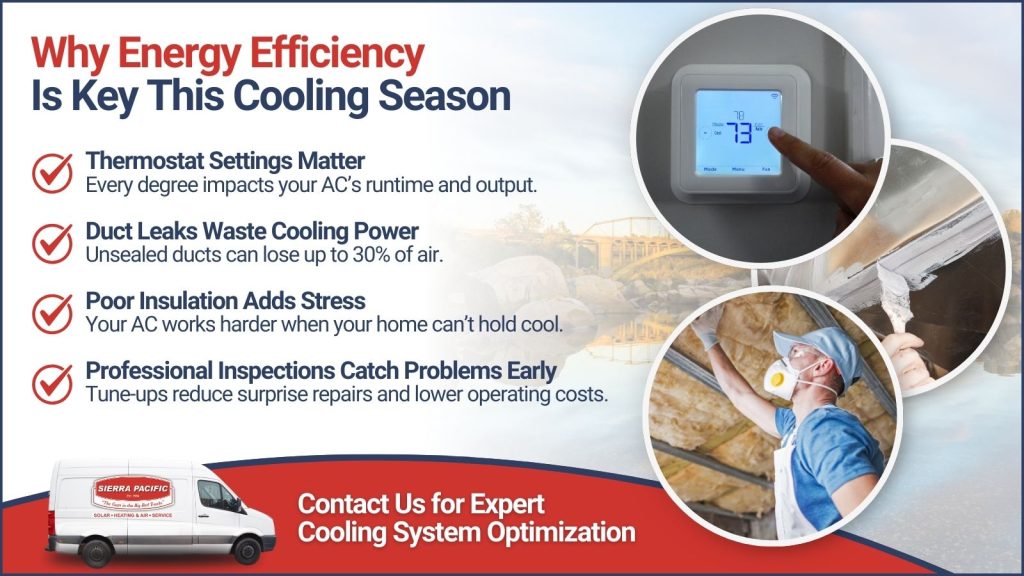As temperatures rise, so does your home’s energy use—especially when it comes to keeping your indoor spaces cool and comfortable. We believe that an energy-efficient home is a happier, more affordable home. Keep reading to learn what factors affect your AC energy usage, tips to improve efficiency, and how to better understand your utility bill this season.

Factors That Affect Your AC Energy Consumption
1. System Age and Efficiency Rating – Older air conditioners often operate with lower Seasonal Energy Efficiency Ratios (SEER ratings), meaning they consume more energy to provide the same level of cooling as a newer, high-efficiency unit. If your system is over 10–15 years old, it may be time to consider an upgrade to a model with a higher SEER rating.
2. Maintenance and Condition – A neglected AC system has to work harder to cool your home, using more energy in the process. Dirty filters, clogged coils, low refrigerant levels, and worn-out parts can all contribute to higher electricity use.
3. Thermostat Settings – The closer your indoor temperature setting is to the outdoor temperature, the less work your AC has to do. Lowering the thermostat by just a few degrees can cause a significant increase in energy consumption.
4. Home Insulation and Sealing – Poorly insulated homes or homes with air leaks lose cooled air, causing your system to cycle more frequently. Insulation, weatherstripping, and sealing gaps can help maintain comfortable indoor temperatures without overworking your AC.
5. Ductwork Condition – Leaky or poorly insulated ducts can waste up to 30% of your cooling energy. Ensuring your ductwork is properly sealed and maintained plays a key role in overall system efficiency.
Tips to Save Money on Cooling Costs
Small steps can add up quickly:
- Schedule Professional AC Maintenance – A yearly maintenance appointment ensures your system is clean, tuned-up, and operating at its best. Preventive maintenance can also catch minor issues before they become expensive repairs.
- Adjust Your Thermostat – Set your thermostat as high as comfortably possible—78°F is a recommended target when you’re home, and even higher when you’re away. Using a programmable or smart thermostat can automate these adjustments and optimize savings.
- Change Filters Regularly – A clogged filter restricts airflow and causes your AC to work harder. Replace or clean filters every 1–3 months to maintain optimal performance.
- Use Ceiling Fans Wisely – Ceiling fans can make a room feel cooler by circulating air, allowing you to set your thermostat a few degrees higher without sacrificing comfort. Just remember to turn fans off when leaving the room—they cool people, not spaces.
- Seal and Insulate – Improve your home’s insulation and seal around doors, windows, and ductwork to prevent cool air from escaping and warm air from entering.
- Limit Heat-Producing Activities – Try to minimize activities that generate heat, such as cooking on the stove or using the dryer, during the hottest parts of the day. Shading windows and using energy-efficient lighting also helps reduce indoor heat gain.
How to Understand Your Utility Bill
Your utility bill likely includes several components:
- Energy Usage (kWh): The total amount of electricity you used during the billing cycle.
- Rate per kWh: How much you are charged for each kilowatt-hour used.
- Demand Charges (if applicable): Higher rates during peak usage periods.
- Taxes and Fees: Additional regulatory and service charges.
By comparing your usage across months and years, you can spot trends. A sudden spike in consumption often signals an issue with your HVAC system, insulation, or home habits. Monitoring these patterns helps you make informed decisions about energy conservation.
Contact Sierra Pacific Home & Comfort, Inc. today to schedule your HVAC services as soon as possible. You can always trust The Guys in the Big Red Trucks.

